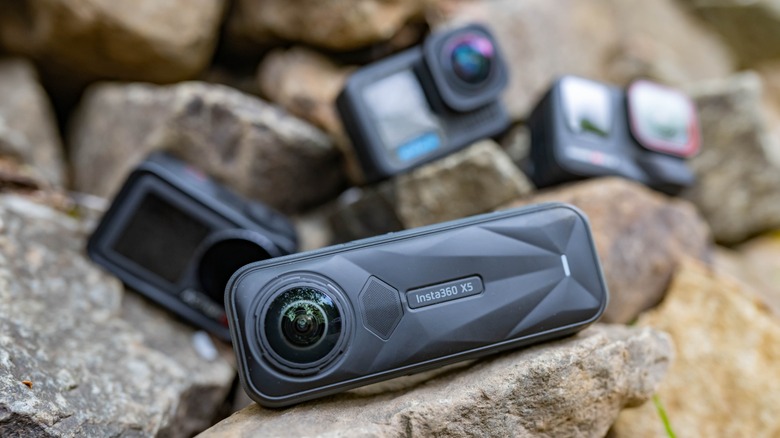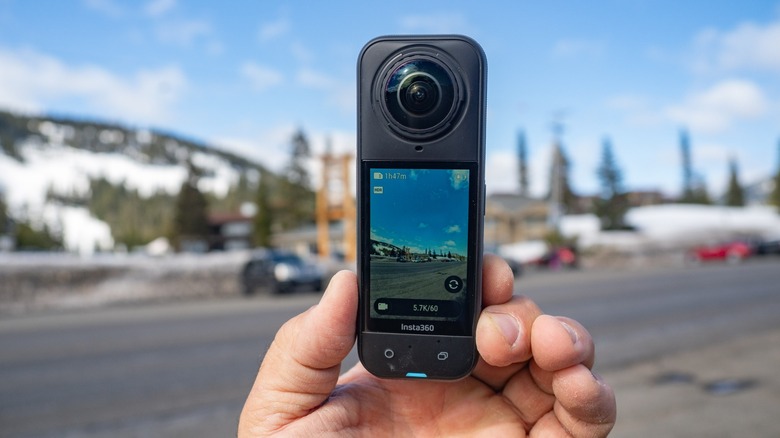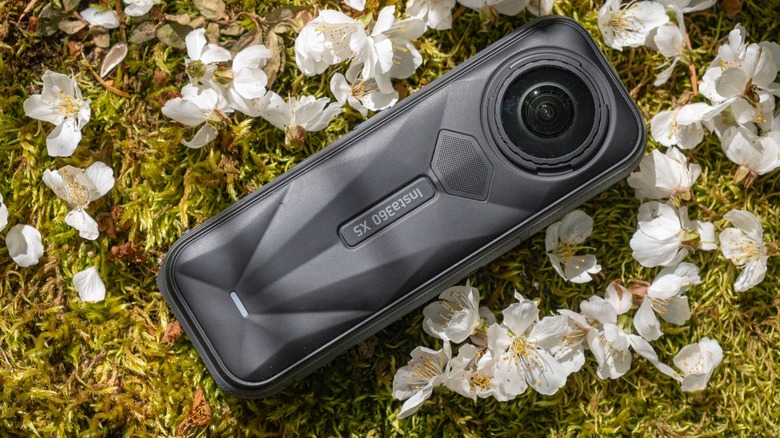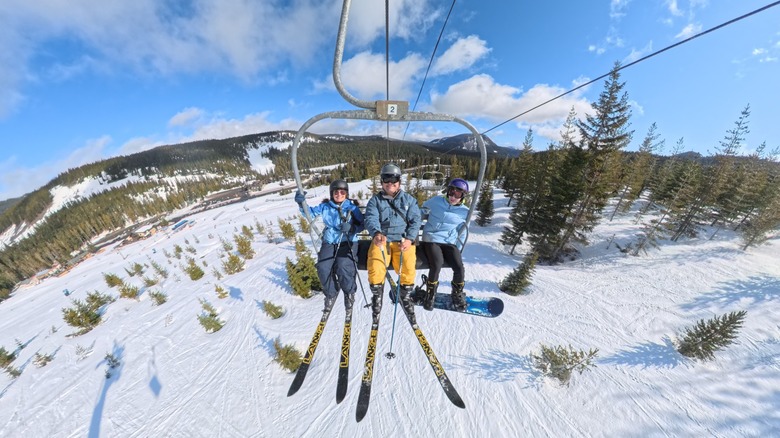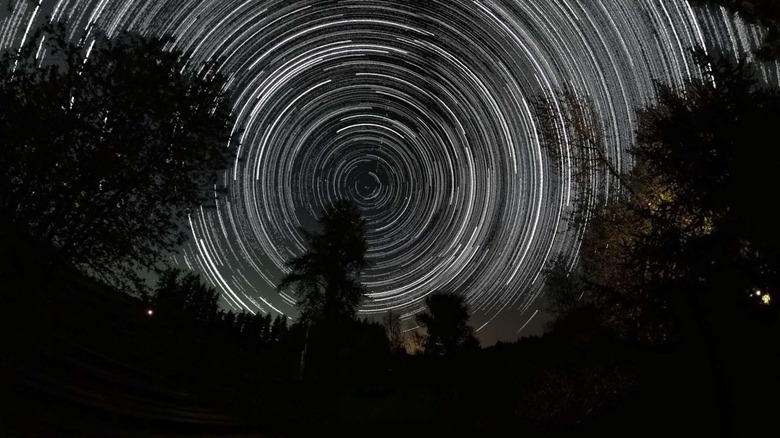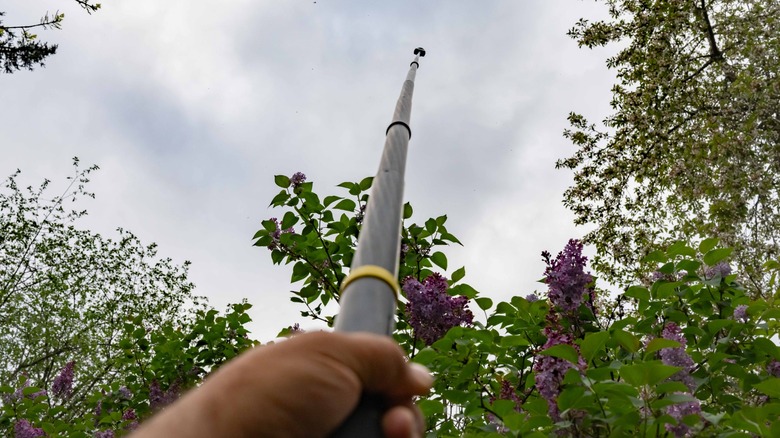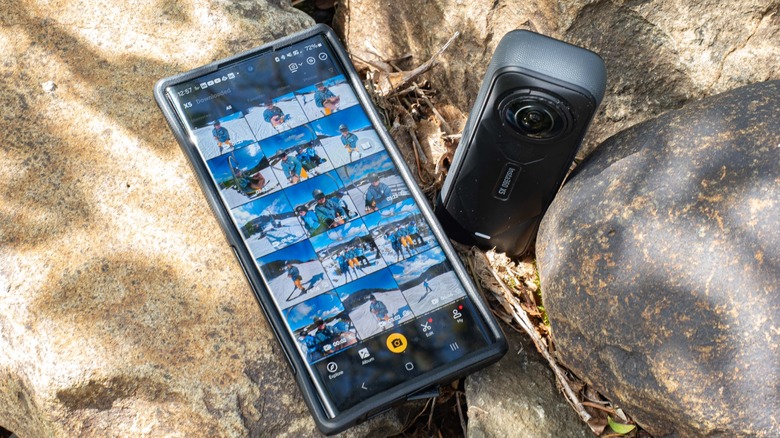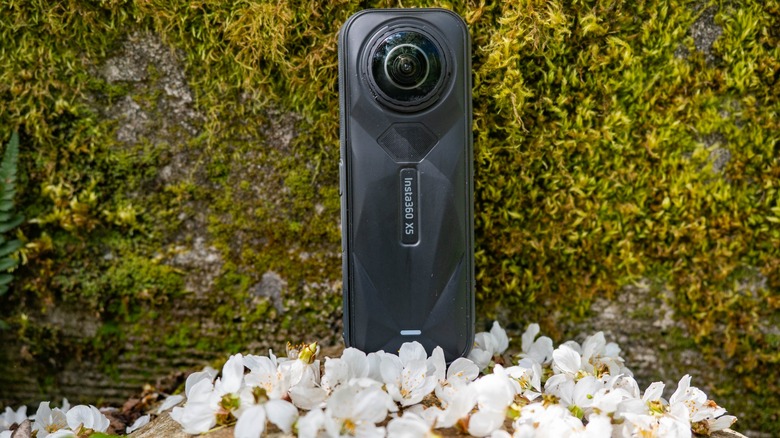12 Reasons Why The Insta360 X5 Is Better Than An Action Camera
We may receive a commission on purchases made from links.
Despite a long established overlap between 360-degree cameras and action cameras, it was not until the recent launch of the Insta360 X5 that one might actually consider such a camera a full-on replacement for an action camera. Thanks to a few key innovations, the X5 may well be the tipping point where the 360 camera really takes over. It might even beat action cameras at their own game.
A 360 camera is literally a camera which captures a 360-degree sphere around it, recording everything all at once. They typically feature two cameras with ultra-wide angle lenses on either side of a slim body; the resulting two 180-degree views are later stitched together either in-camera or by software. With Insta360's flagship cameras, and most other modern 360 cameras, this stitching occurs in-camera. The camera itself, and often the pole supporting the camera are rendered entirely or largely invisible. Alternately, an action camera utilizes a single, wide angle lens in a rugged, waterproof body, typically with electronic image stabilization.
As we will see, the line delineating these two camera genres has blurred significantly, and with the Insta360 X5 one may well ask why you would buy an action camera instead. The camera (provided by Insta360 for our full Insta360 X5 review) is equipped with a new sensor, better processing capabilities, and major durability upgrades over the previous X4 camera. Here's what makes it worth considering.
The widest angle camera possible
Action cameras typically have extremely wide angle lenses, and GoPro even sells a lens mod to push that view wider, but nothing can beat a 360 camera for getting as much as possible in the picture. Not only can the X5 see everything in front of it, but everything behind as well. The result is that you can get some extremely compelling POV (Point of View) shots, and take in views which would otherwise be cutoff by the edges of your field of view. For example, if you're standing at the foot of a tall building, cliff, or tree, you can easily fit both the top of that object and its base into the same image, no matter how close you may be.
A great example of where the extreme wide angle of the Insta360 X5 can come in handy is when you're skiing or snowboarding. When filming this activity I want to be able to show not just the view in front of me, but also my skis, ski poles, hands, and arms. This helps impart the intensity of the action and a sense of scale to the video. An action camera can go wide, but even the widest-angle action camera (GoPro Hero 13 Black with the Ultra Wide Lens Mod) can't go as wide as the X5.
It's at least as tough as an action camera
With a more durable, replaceable lens and improved waterproofing, I've found that the X5 is at least as tough as any action camera on the market. This parity in durability is important, as previously 360 cameras were somewhat fragile. Prior to the X5, if you didn't use lens protectors and you treated a 360 camera like an action camera, you were likely to irreparably damage the lenses. Now, I am more confident in these lenses' scratch-resistance than I am about many of the best action cameras I've tested over the years.
I took the X5 out skiing, and immediately banged it against the metal hoop of the chair lift. I'm pretty sure it hit glass-first, but afterward I couldn't tell, because there wasn't a single detectable scratch. This was later confirmed by a second incident on the chair lift, and by its survival of the numerous tumbles I took while goofing around in the dingweeds. Lens protectors are available for the X5, and they are basically the same as those for the Insta360 X4, but unlike the X4, the X5 really doesn't need them.
Of course, used in hurley-burley fashion, even the toughest protective glass may still become scratched. That's why the fact that the X5 now features user replaceable lenses is so important. This is something which has long been inherent in most action cameras, and which was key to making 360 cameras competitive in the same applications as action cameras. Additionally, the X5 is IP68 rated, meaning it's more waterproof than its predecessor.
Single lens mode transforms it into an action camera
Typically, the easy workflow and operation of an action camera is a big reason many opt for them instead of a 360 camera. However, by simply turning on single-lens mode, the X5 suddenly shoots video exactly like an action camera. It can operate with the same useful simplicity as an action camera should you need it.
In this mode, the X5 is relatively limited compared to modern action cameras, but it's good enough that in most such applications it can go toe-to-toe with action cameras shooting in single-lens mode. You can even choose between different preset crops with varying levels of distortion correction when filming in single lens mode like you would on a traditional action camera. Of course, it's better to film in 360 and take full advantage of the post-processing flexibility this offers. Also, Insta360 offers simplified controls in its software to reduce the complexity of processing 360 footage and to streamline content production.
Larger sensors than you'll find in current action cameras
Action cameras currently only offer 1/1.3-inch sensors, while the X5 is equipped with slightly larger 1/1.28-inch sensors. Alongside software and processor upgrades, this enables a big improvement in low light filming capability. That 0.02-inch advantage doesn't sound like much, but I'll take whatever boost I can get in this regard, and it's a huge step up from the ½-inch sensor found in last year's X4 model. This means you're getting the same sort of low light performance from the X5 as you'd expect from the Insta360 Ace Pro 2, which I praised in my review for its capabilities in this regard. Additionally, a larger sensor means more dynamic range, and a general increase in image quality.
It's also worth noting the impact that the new 5nm AI chip, dual Pro Imaging chips, and a new algorithm in the X5 has on low light performance. The upshot is that the X5 has finally smoothed out the limitations which previously were almost universally inherent in 360 camera when it comes to image quality. It used to be I'd get my 360 photos and videos home and processed, and think "that looks okay," but with the X5 I look at the final result and think "that looks great!"
Never miss a shot
All too often when I'm filming with an action camera, I make a mistake when mounting it, or it gets bumped out of alignment, and the footage is rendered basically useless. With the Insta360 X5 you essentially no longer run the risk of a poorly angled camera losing the shot. 360 photos and videos aren't just about being merely wide angle, it's also about having the option to extract many different viewpoints of your subject from a single capture, and to be able to adjust the field of view and distortion after the fact. For example, when crashing out on the ski hill, I was able to record each tumble in all its embarrassing glory. While the camera did get covered in snow, it was still able to fully record my bumbling disasters, whereas the GoPro I had mounted to my helmet was launched from its helmet mount into a snowbank, resulting in far less compelling footage of the crash.
Also from the ski hill, I was able to film a snowboarder doing tricks on the terrain park by skiing alongside the jumps. I didn't need to pay attention to which way the camera was pointing, and so was able to keep my attention on safely making it down the hill. The results were phenomenal — when filming in 8K, I could even crop in for a tight shot while retaining a crisp image.
Film vlogs and catch the action at the same time
Since the Insta360 X5 has two cameras facing either direction, you can record yourself and what you're seeing simultaneously. What's more, the upgraded microphone in the X5 produces high quality audio recordings, and since it's all captured with the same microphone it's easy to sync different clips pulled out of a single recording. This all greatly simplifies production, and is a serious boon to solo creators.
For vlogging, the press-and-record simplicity of a 360 camera, coupled with the excellent high dynamic range of its new sensor, plus the reliable high quality audio capture that's highly wind resistant, really help to reduce distractions so you can live in the moment and focus on relaying your message to your audience. While I haven't had the opportunity to test it myself, there's also optional wireless Insta360 Mic Air which is a small lav mic that pairs with the X5 — this is something that should make the system even more attractive to vloggers.
Better still photos and amazing creative options
It's far easier to get a great selfie or group portrait with the Insta360 X5 using an "invisible selfie stick" than with a traditional action camera. There's a lot of creative ways to process a 360 image, such as "small world" effects, one-shot panoramas, and VR-ready 360-degree views. Personally, I've always been more interested in the video side of 360 cameras, but using the X5 I've gained a new appreciation of capturing still photos with 360 cameras. This is partly due to the higher level of image quality it provides.
A 360 camera on a selfie stick is the best way of capturing group photos possible, such as is seen in this image captured from a chairlift. There's no need to compose your shot, and no time for your subjects to grow restless or lose the sincerity of their smiles. It's also helpful in locations where your view would otherwise be obstructed for a photograph, and really there's no better option than this for grabbing a quick, high-quality selfie.
Whole-sky astrophotography images and timelapse videos
The next time we see a major aurora event, this is the camera you want to have recording it. 360 cameras have long been among my favorite tools for capturing the night sky, and in this regard the X5 has really upped the ante. Those larger sensors make for whole-sky recording that delivers far better results than previous generations. This is one area where you will typically be using the larger part of the 360 degree sphere, thus producing very high resolution images and video.
The DJI Osmo Action 5 Pro impressed me in particular last year with its ability to capture long timelapses of the night sky, but it's got nothing on the Insta360 X5. In addition to the sheer quality of the imagery it produces, the X5 and its companion software offer such flexibility in post production that I was able to take just 3 nights worth of recordings and export many very different clips to create the highly engaging video featured here. That would not be possible with any traditional action camera.
There's one caveat here, and that is that you need to use the Insta360 mobile app to create star trail and starlapse videos and images. It's frustrating that this isn't really available in the Insta360 Studio software on desktop computers.
Aerial photography without a drone
With an extra-long selfie stick, it's possible to record drone-like video in places where you can't fly a drone. This also enables you to capture unobstructed images in places where your view is otherwise obscured by vegetation, crowds, or fences. The normal Invisible Selfie Stick can be helpful in this regard, but I'd highly recommend also picking up the Extended Edition Selfie Stick, which stretches out to a whopping 10 feet long.
National Parks and many other locations now ban drones, but most won't kick you out for carrying an extra long selfie stick. For video it's particularly effective to achieve that drone-like effect if you're riding a bicycle or holding the pole out the sunroof of your vehicle, such as I did last year in Olympic National Park with the Insta360 X4. Just be sure to be extra careful when using a very long pole to avoid any accidents.
Software is a cut above the rest
GoPro and DJI have great software in their cameras and utilize excellent companion apps, but Insta360 has really fought its way to the top of the pile in this regard. Both its mobile app and its desktop editing software is better than what's offered by just about any other camera manufacturer. Also, the ease and swiftness of the connection between camera and mobile device is so much better than anything else I've ever used. There's no hassle if you want to quickly edit and export a video from the X5 on through the Insta360 mobile app. The app instantly sees the X5, and with a tap and a second or two of waiting, your images and videos are all right there, ready to edit.
This powerful software and connectivity is what makes the X5 able to remain competitive in terms of ease of workflow, given that 360 footage requires extra steps to create ready-to-share media. That means you can take advantage of the aforementioned flexibility of 8K 360 footage without the editing itself being a significant burden. It reduces that edge which single-lens cameras possess in terms of workflow.
Other 360 cameras
As dominant as Insta360 has become in the 360 camera market, other options still exist. GoPro has its Hero Max camera, though that was released way back in 2019 and is very much in need of a massively updated successor. However, it is attractively priced at just $349 on Amazon, and has an integrated folding action camera mount which is handy
The Kandao QooCam 3 Ultra is perhaps the greatest rival to the X5 given its 8K video capture capability, but it has much smaller image sensors and costs even more at $599, which is $50 more than the Insta360 X5 which is available for $549 on Amazon.
If you're looking to upgrade from Insta360's previous 360 cameras, I would say it's definitely worth the money if you own an Insta360 One X, Insta360 X2, Insta360 X3, or Insta360 One RS 1-inch edition. The X5 is an absolutely massive step up from those cameras. However, the question is a little more difficult if you own last year's X4, which remains an excellent and relevant camera. It's still a big upgrade from the X4 to the X5, but the X4 is much closer to the capabilities of the X5 than the X3 was to the X4. Keep in mind however, that I don't feel that the X4 is nearly as capable of replacing an action camera in your kit as the X5 is, largely due to the X5 being significantly more durable.
Will 360 cameras make action cameras obsolete?
In many ways the X5 does almost everything an action camera does, and it often does it better. The sheer versatility of being able to capture an 8K 360 video in a rugged, compact camera is incredible, and for a lot of creators, the X5 is certainly a better choice than a traditional action camera. However, action cameras are far from dead yet.
Action cameras deliver better slow motion performance; while I was able to get some great slow motion shots with the X5, they were only filmed at 60fps, and at a lower resolution. Action cameras such as the DJI Action 5 Pro can typically capture crisp 4K 120fps footage, and if we're talking sheer resolution, the Insta360 Ace Pro 2 can record 8K footage from its single camera, rather than the X5 where that 8K recording is split between the two separate halves of the 360 camera. It's also more difficult to mount a 360 camera than a single-lens camera.
Looking forward to future Insta360 cameras, the area which most needs improvement is slow motion capability. 8K 60fps and 5.7K 120fps seems like a logical next step for a hypothetical X6, which would enable both high resolution slow motion, and ultra slow motion at lower resolutions, plus it would be great to be able to playback 8K 360 footage in VR at 60fps. Additionally, I would like to see more options and capabilities available in single-lens mode. However, as it stands, there's no reason to hold off on adding a 360 camera to your kit or upgrading your older model — the X5 is where the action is.
